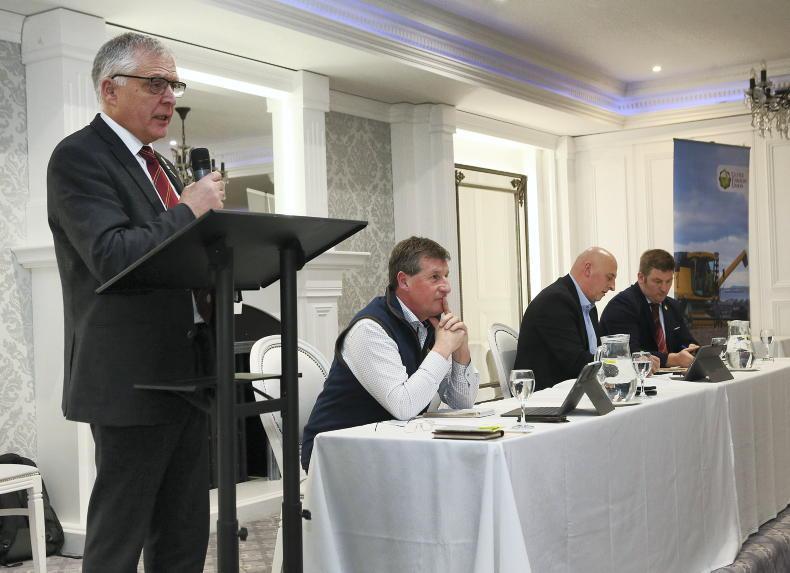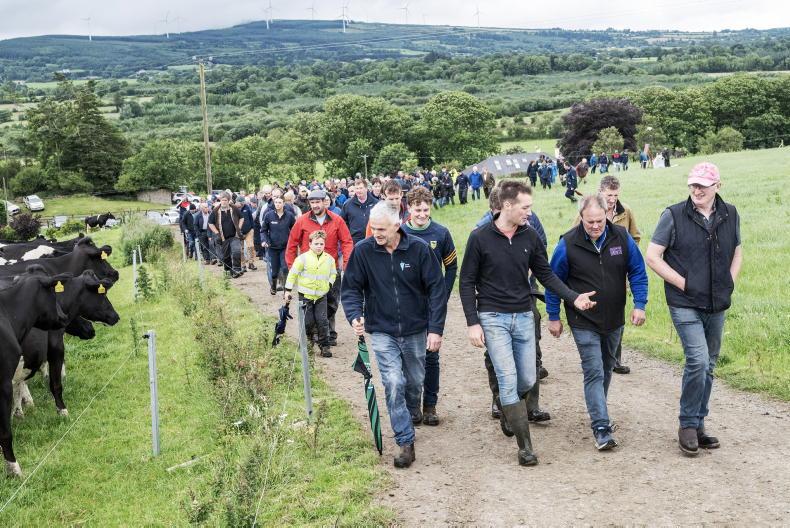There is a recognition within DAERA that biogenic methane acts differently in the atmosphere to other greenhouse gases (GHGs) and should not be assessed in the same way as carbon dioxide (CO2) from fossil fuels.
Addressing attendees at an online public consultation event on carbon emissions reduction targets, Paddy Savage from DAERA acknowledged there is ongoing scientific debate about the best way to account for GHGs.
He referred to a recent intervention by leading scientists who warned that the current system used to assess the Global Warming Potential of GHGs over a 100-year period (GWP100) could be misleading.
In essence, the GWP100 metric does not allow for the fact biogenic methane released by ruminants is short-lived in the atmosphere compared to CO2 from fossil-fuel burning, which persists for centuries.
It is a crucial issue for livestock farming, given methane currently accounts for two-thirds of emissions from NI agriculture. While science will deliver feed additives, etc, that can cut methane, the reality is that the easiest way to reduce the gas is to keep less livestock.
Alternative
The alternative GWP* metric aims to capture this difference between shorter and longer-lived GHGs.
“Assessing the impact based on GWP* is something we will move towards doing,” said Savage.
However, he pointed out that national and international inventories still use GWP100, so DAERA is obliged to report against that metric.
It is also the metric used by the UK Climate Change Committee (CCC), the expert body which advises government on how the 2050 net zero target can be achieved.
NI doesn’t have to
implement CCC advice
Experts on the UK Climate Change Committee (CCC) have produced various reports for NI government departments on how we might meet net zero targets.
Initially, the CCC suggested NI needs to cut emissions by 82% as part of a fair contribution to UK net zero by 2050.
NI net zero
However, in March 2022, Stormont MLAs went against that advice and opted instead for a NI net zero target for 2050.
In a report published in March 2023, the CCC set out the actions now required, including a cut in cattle and sheep by around 18% by 2030, and potentially a halving in livestock numbers by 2050.
Initially, the CCC suggested NI needs to cut emissions by 82%
In addition, NI will have to make a rapid switch to electric vehicles, restore peatland, grow thousands of hectares of trees and invest billions in new technology to capture and store carbon.
So, do NI government departments have to follow this CCC advice?
“The views of the CCC are not necessarily the position of NI departments,” responded DAERA Director Jane Corderoy, who added that the key issue is that “we get to the same point”.
‘Massive’ challenge
However, she accepted that getting to net zero will be “a massive challenge”, requiring “massive investment” and behavioural change right across society; but she also maintained there is a significant opportunity to grow the green economy and transform lives for the better.
Her colleague, Anthony Courtney, was also keen to look for positives, suggesting that net zero is “doable”, including for NI agriculture.
Livestock cuts off the table for now
The ongoing DAERA consultation, which runs to 11 October 2023, seeks views across two main areas.
The first is around interim targets for 2030 and 2040, with the CCC advising that NI needs to cut GHGs by at least 48% (when compared to 1990 levels) by 2030 and at least 77% by 2040.
Between 1990 and 2021, GHG emissions were down 23%.
The CCC advises that NI needs to cut GHGs by at least 48% (when compared to 1990 levels) by 2030 and at least 77% by 2040
There are also three five-year carbon budgets, the first of which runs from 2023 to 2027 and comes with a target to cut emissions by an average of 33%.
The second main part of the DAERA consultation relates to public views on the wider CCC advice.
Livestock
In the consultation document, DAERA sets out how new policy programmes (including a beef carbon reduction scheme) will mean agriculture delivers against the target in the first five-year carbon budget (to 2027).
Beyond that, science, livestock genetics and new innovations will have a significant impact on GHG emissions, notes the DAERA document.
But the next two five-year budgets, running from 2028 to 2032 and 2033 to 2037, require reductions of 48% and 62% respectively, with the clear advice from the CCC that cuts to livestock will be required.
Science, livestock genetics and new innovations will have a significant impact on GHG emissions
That advice was carefully side-stepped by DAERA officials at last week’s consultation event. “It is not Department policy for a mandatory reduction in livestock early on,” noted Paddy Savage.
Later this year, DAERA is to consult on detailed actions required to deliver targets in the five-year period to 2027.
Read more
Scientists set out limitations with carbon calculators
Carbon audits should show warming effect
There is a recognition within DAERA that biogenic methane acts differently in the atmosphere to other greenhouse gases (GHGs) and should not be assessed in the same way as carbon dioxide (CO2) from fossil fuels.
Addressing attendees at an online public consultation event on carbon emissions reduction targets, Paddy Savage from DAERA acknowledged there is ongoing scientific debate about the best way to account for GHGs.
He referred to a recent intervention by leading scientists who warned that the current system used to assess the Global Warming Potential of GHGs over a 100-year period (GWP100) could be misleading.
In essence, the GWP100 metric does not allow for the fact biogenic methane released by ruminants is short-lived in the atmosphere compared to CO2 from fossil-fuel burning, which persists for centuries.
It is a crucial issue for livestock farming, given methane currently accounts for two-thirds of emissions from NI agriculture. While science will deliver feed additives, etc, that can cut methane, the reality is that the easiest way to reduce the gas is to keep less livestock.
Alternative
The alternative GWP* metric aims to capture this difference between shorter and longer-lived GHGs.
“Assessing the impact based on GWP* is something we will move towards doing,” said Savage.
However, he pointed out that national and international inventories still use GWP100, so DAERA is obliged to report against that metric.
It is also the metric used by the UK Climate Change Committee (CCC), the expert body which advises government on how the 2050 net zero target can be achieved.
NI doesn’t have to
implement CCC advice
Experts on the UK Climate Change Committee (CCC) have produced various reports for NI government departments on how we might meet net zero targets.
Initially, the CCC suggested NI needs to cut emissions by 82% as part of a fair contribution to UK net zero by 2050.
NI net zero
However, in March 2022, Stormont MLAs went against that advice and opted instead for a NI net zero target for 2050.
In a report published in March 2023, the CCC set out the actions now required, including a cut in cattle and sheep by around 18% by 2030, and potentially a halving in livestock numbers by 2050.
Initially, the CCC suggested NI needs to cut emissions by 82%
In addition, NI will have to make a rapid switch to electric vehicles, restore peatland, grow thousands of hectares of trees and invest billions in new technology to capture and store carbon.
So, do NI government departments have to follow this CCC advice?
“The views of the CCC are not necessarily the position of NI departments,” responded DAERA Director Jane Corderoy, who added that the key issue is that “we get to the same point”.
‘Massive’ challenge
However, she accepted that getting to net zero will be “a massive challenge”, requiring “massive investment” and behavioural change right across society; but she also maintained there is a significant opportunity to grow the green economy and transform lives for the better.
Her colleague, Anthony Courtney, was also keen to look for positives, suggesting that net zero is “doable”, including for NI agriculture.
Livestock cuts off the table for now
The ongoing DAERA consultation, which runs to 11 October 2023, seeks views across two main areas.
The first is around interim targets for 2030 and 2040, with the CCC advising that NI needs to cut GHGs by at least 48% (when compared to 1990 levels) by 2030 and at least 77% by 2040.
Between 1990 and 2021, GHG emissions were down 23%.
The CCC advises that NI needs to cut GHGs by at least 48% (when compared to 1990 levels) by 2030 and at least 77% by 2040
There are also three five-year carbon budgets, the first of which runs from 2023 to 2027 and comes with a target to cut emissions by an average of 33%.
The second main part of the DAERA consultation relates to public views on the wider CCC advice.
Livestock
In the consultation document, DAERA sets out how new policy programmes (including a beef carbon reduction scheme) will mean agriculture delivers against the target in the first five-year carbon budget (to 2027).
Beyond that, science, livestock genetics and new innovations will have a significant impact on GHG emissions, notes the DAERA document.
But the next two five-year budgets, running from 2028 to 2032 and 2033 to 2037, require reductions of 48% and 62% respectively, with the clear advice from the CCC that cuts to livestock will be required.
Science, livestock genetics and new innovations will have a significant impact on GHG emissions
That advice was carefully side-stepped by DAERA officials at last week’s consultation event. “It is not Department policy for a mandatory reduction in livestock early on,” noted Paddy Savage.
Later this year, DAERA is to consult on detailed actions required to deliver targets in the five-year period to 2027.
Read more
Scientists set out limitations with carbon calculators
Carbon audits should show warming effect










SHARING OPTIONS